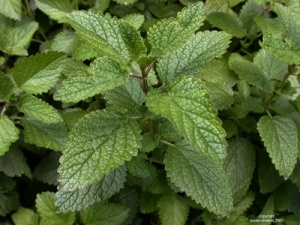Melissa officinale
| See Also | Botanical Monographs |
|---|
Lemon Balm Melissa officinale has a long history of use and can be cited in Roman, Arabic, and British herbal-lore. As a tea it has been enjoyed for its flavour and relaxation properties. It has historically been used as a mild sedative for anxiety, nervousness, and to aid in longevity. To explore the characteristics, medicinal uses and prescribing considerations of this herb in more detail, check out the references indicated.[1], [2]
Contents
Characteristics
- Common Names: Lemon balm, Common balm, Bee balm, Balm, Honeyplant, Sweet balm, Cure-all
- Family: Lamiaceae
- Habitat: Melissa officinale can be found in Southern Europe, Asia Minor, and Northern Africa. It is now also naturalized to Europe and North America.
- Parts Used: whole plant before flowering (45% alcohol)
- Constituents: volatile oils, tannins, flavonoids (rosmarinic acid)
- Medicinal Actions: limbic sedative, antispasmodic, carminative, nervine, TSH antagonist,
Uses
Historical Uses:
Melissa has a long history of use and can be cited in Roman, Arabic, and British herbal-lore. As a tea it has been enjoyed for its flavour and relaxation properties. It has historically been used as a mild sedative for anxiety, depression, nervousness, and to aid in longevity. It can also be found in perfumes and cosmetics.
Medicinal Uses:
Internal
- nervous tension, nervous stomach associated with anxiety and depression
- used as tea to lift mild depression
- relieves spasms and colic associated with nervousness, dyspepsia, stomach sedative, GI sedative
- combines well with Mentha piperita for IBS (1:1)
- herbal tranquilizer for autonomic nervous problems; acts on the limbic system
- insomnia due to nervousness or restlessness
- cardiac problems associated with nervousness and depression (tachycardia, palpitations, reactive heart)
- Other Conditions
External
- cream and bath salts/oils to help with skin irritations
- insect bites
- used as part of aromatherapy (referred to as melissa)
Prescribing Considerations
The information provided is intended to augment the treatment from a naturopathic doctor or other trained medical professional. Although most herbs are generally safe, it is recommended that you avoid self-prescribing especially when there is an underlying ongoing medical condition, if you are on any prescription medications or if you are pregnant or breastfeeding.
Formulations and Preparation
- Tincture - up to 60 drops three times daily
- Tea - 2 tsp/cup, steep covered, use as needed
- Oils for use in skin care products
Safety
The safety and prescribing considerations for this herb include:[3], [4]
- Generally regarded as safe.
- Side-effects are not generally seen.
- Drug-Herb Interactions rare.
References
- ↑ Boon Heather, Smith Michael (2009) 55 Most Common Medicinal Herbs: The Complete Natural Medicine Guide Second Edition Institute of Naturopathic Education and Research, CCNM Toronto.
- ↑ Godfrey Anthony, Saunders Paul, Barlow Kerry, Gowan Matt (2011) Principles and Practices of Naturopathic Botanical Medicine, Advanced Botanical Medicine. V3 CCNM Press, Toronto.
- ↑ Stargrove Mitchell Bebell, Treasure Jonathan, McKee Dwight L (2008) Herb, Nutrient and Drug Interactions: Clinical Implications and Therapeutic Strategies.
- ↑ Brinker Francis (1997) Herbal Contraindications and Drug Interactions: Plus Herbal Adjuncts With Medicines, 4th Edition Eclectic Medical Publications.
